[English](README.en.md) | [日本語](README.md)
# raspimouse_ros2_examples
[](https://github.com/rt-net/raspimouse_ros2_examples/actions?query=workflow%3Aindustrial_ci+branch%3Amaster)
Raspberry Pi MouseのROS 2サンプルコード集です。
ROS1のサンプルコード集は[こちら](https://github.com/rt-net/raspimouse_ros_examples/blob/master/README.md)。
Gazebo(シミュレータ)でも動作します。詳細は[こちら](https://github.com/rt-net/raspimouse_sim/blob/ros2/README.md)。
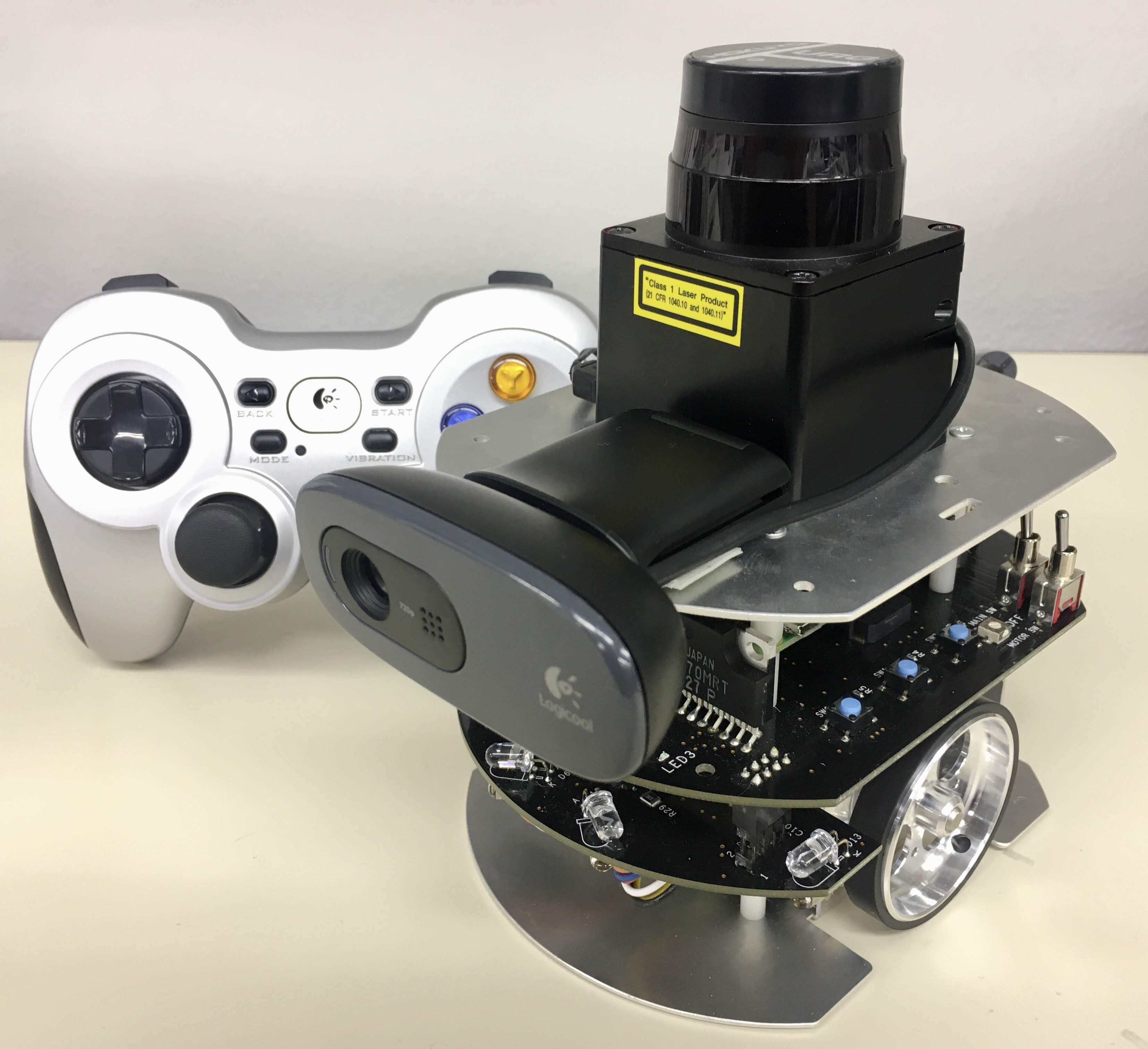 ## Supported ROS 2 distributions
- [Humble](https://github.com/rt-net/raspimouse_ros2_examples/tree/humble)
- [Jazzy](https://github.com/rt-net/raspimouse_ros2_examples/tree/jazzy) (This branch)
## Requirements
- Raspberry Pi Mouse
- https://rt-net.jp/products/raspberrypimousev3/
- Linux OS
- Ubuntu server 24.04
- Device Driver
- [rt-net/RaspberryPiMouse](https://github.com/rt-net/RaspberryPiMouse)
- ROS
- [Jazzy Jalisco](https://docs.ros.org/en/jazzy/index.html)
- Raspberry Pi Mouse ROS 2 package
- https://github.com/rt-net/raspimouse2
- Remote Computer (Optional)
- ROS
- [Jazzy Jalisco](https://docs.ros.org/en/jazzy/index.html)
- Raspberry Pi Mouse ROS 2 package
- https://github.com/rt-net/raspimouse2
## Installation
```sh
$ cd ~/ros2_ws/src
# Clone package
$ git clone -b $ROS_DISTRO https://github.com/rt-net/raspimouse_ros2_examples.git
# Install dependencies
$ rosdep install -r -y --from-paths . --ignore-src
# Build & Install
$ cd ~/ros2_ws
$ colcon build --symlink-install
$ source ~/ros2_ws/install/setup.bash
```
## License
このリポジトリはApache 2.0ライセンスの元、公開されています。
ライセンスについては[LICENSE](./LICENSE)を参照ください。
## How To Use Examples
- [joystick_control](#joystick_control)
- [object_tracking](#object_tracking)
- [line_follower](#line_follower)
- [camera_line_follower](#camera_line_follower)
- [SLAM](#slam)
- [direction_controller](#direction_controller)
---
### joystick_control
ジョイスティックコントローラでRaspberryPiMouseを動かすコード例です。
#### Requirements
- Joystick Controller
- [Logicool Wireless Gamepad F710](https://gaming.logicool.co.jp/ja-jp/products/gamepads/f710-wireless-gamepad.html#940-0001440)
- [SONY DUALSHOCK 3](https://www.jp.playstation.com/ps3/peripheral/cechzc2j.html)
#### How to use
次のコマンドでノードを起動します。
```sh
# Use F710
$ ros2 launch raspimouse_ros2_examples teleop_joy.launch.py joydev:="/dev/input/js0" joyconfig:=f710 mouse:=true
# Use DUALSHOCK 3
$ ros2 launch raspimouse_ros2_examples teleop_joy.launch.py joydev:="/dev/input/js0" joyconfig:=dualshock3 mouse:=true
# Control from remote computer
## on RaspberryPiMouse
$ ros2 run raspimouse raspimouse
## on remote computer
$ ros2 launch raspimouse_ros2_examples teleop_joy.launch.py mouse:=false
```
デフォルトのキー割り当てはこちらです。
Logicool Wireless Gamepad F710を使う場合はモード切替スイッチを __D__ (DirectInput Mode)に設定します。
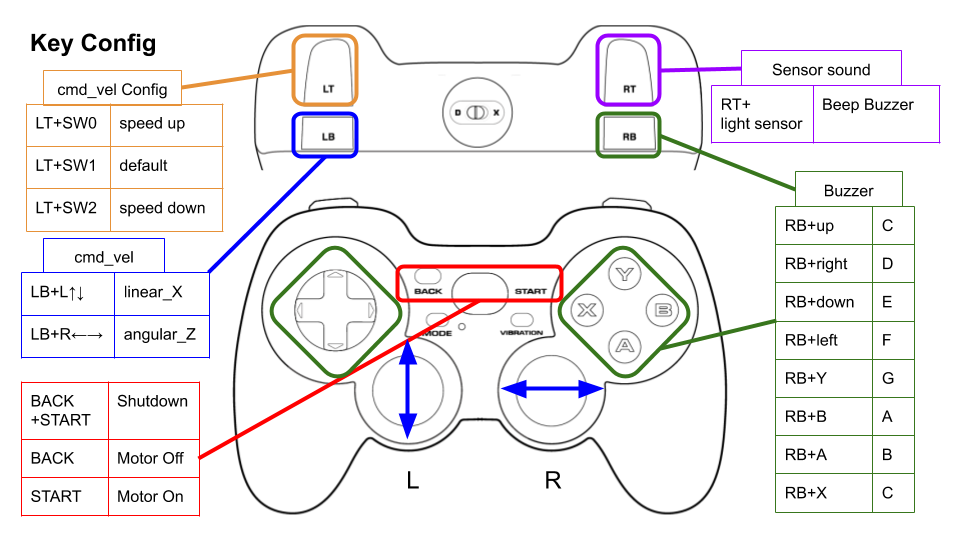
#### Configure
[./config/joy_f710.yml](./config/joy_f710.yml)、[./config/joy_dualshock3.yml](./config/joy_dualshock3.yml)
のキー番号を編集することで、キー割り当てを変更できます。
```yaml
button_shutdown_1 : 8
button_shutdown_2 : 9
button_motor_off : 8
button_motor_on : 9
button_cmd_enable : 4
```
#### Videos
[](https://youtu.be/GswxdB8Ia0Y)
[back to example list](#how-to-use-examples)
---
### object_tracking
## Supported ROS 2 distributions
- [Humble](https://github.com/rt-net/raspimouse_ros2_examples/tree/humble)
- [Jazzy](https://github.com/rt-net/raspimouse_ros2_examples/tree/jazzy) (This branch)
## Requirements
- Raspberry Pi Mouse
- https://rt-net.jp/products/raspberrypimousev3/
- Linux OS
- Ubuntu server 24.04
- Device Driver
- [rt-net/RaspberryPiMouse](https://github.com/rt-net/RaspberryPiMouse)
- ROS
- [Jazzy Jalisco](https://docs.ros.org/en/jazzy/index.html)
- Raspberry Pi Mouse ROS 2 package
- https://github.com/rt-net/raspimouse2
- Remote Computer (Optional)
- ROS
- [Jazzy Jalisco](https://docs.ros.org/en/jazzy/index.html)
- Raspberry Pi Mouse ROS 2 package
- https://github.com/rt-net/raspimouse2
## Installation
```sh
$ cd ~/ros2_ws/src
# Clone package
$ git clone -b $ROS_DISTRO https://github.com/rt-net/raspimouse_ros2_examples.git
# Install dependencies
$ rosdep install -r -y --from-paths . --ignore-src
# Build & Install
$ cd ~/ros2_ws
$ colcon build --symlink-install
$ source ~/ros2_ws/install/setup.bash
```
## License
このリポジトリはApache 2.0ライセンスの元、公開されています。
ライセンスについては[LICENSE](./LICENSE)を参照ください。
## How To Use Examples
- [joystick_control](#joystick_control)
- [object_tracking](#object_tracking)
- [line_follower](#line_follower)
- [camera_line_follower](#camera_line_follower)
- [SLAM](#slam)
- [direction_controller](#direction_controller)
---
### joystick_control
ジョイスティックコントローラでRaspberryPiMouseを動かすコード例です。
#### Requirements
- Joystick Controller
- [Logicool Wireless Gamepad F710](https://gaming.logicool.co.jp/ja-jp/products/gamepads/f710-wireless-gamepad.html#940-0001440)
- [SONY DUALSHOCK 3](https://www.jp.playstation.com/ps3/peripheral/cechzc2j.html)
#### How to use
次のコマンドでノードを起動します。
```sh
# Use F710
$ ros2 launch raspimouse_ros2_examples teleop_joy.launch.py joydev:="/dev/input/js0" joyconfig:=f710 mouse:=true
# Use DUALSHOCK 3
$ ros2 launch raspimouse_ros2_examples teleop_joy.launch.py joydev:="/dev/input/js0" joyconfig:=dualshock3 mouse:=true
# Control from remote computer
## on RaspberryPiMouse
$ ros2 run raspimouse raspimouse
## on remote computer
$ ros2 launch raspimouse_ros2_examples teleop_joy.launch.py mouse:=false
```
デフォルトのキー割り当てはこちらです。
Logicool Wireless Gamepad F710を使う場合はモード切替スイッチを __D__ (DirectInput Mode)に設定します。

#### Configure
[./config/joy_f710.yml](./config/joy_f710.yml)、[./config/joy_dualshock3.yml](./config/joy_dualshock3.yml)
のキー番号を編集することで、キー割り当てを変更できます。
```yaml
button_shutdown_1 : 8
button_shutdown_2 : 9
button_motor_off : 8
button_motor_on : 9
button_cmd_enable : 4
```
#### Videos
[](https://youtu.be/GswxdB8Ia0Y)
[back to example list](#how-to-use-examples)
---
### object_tracking
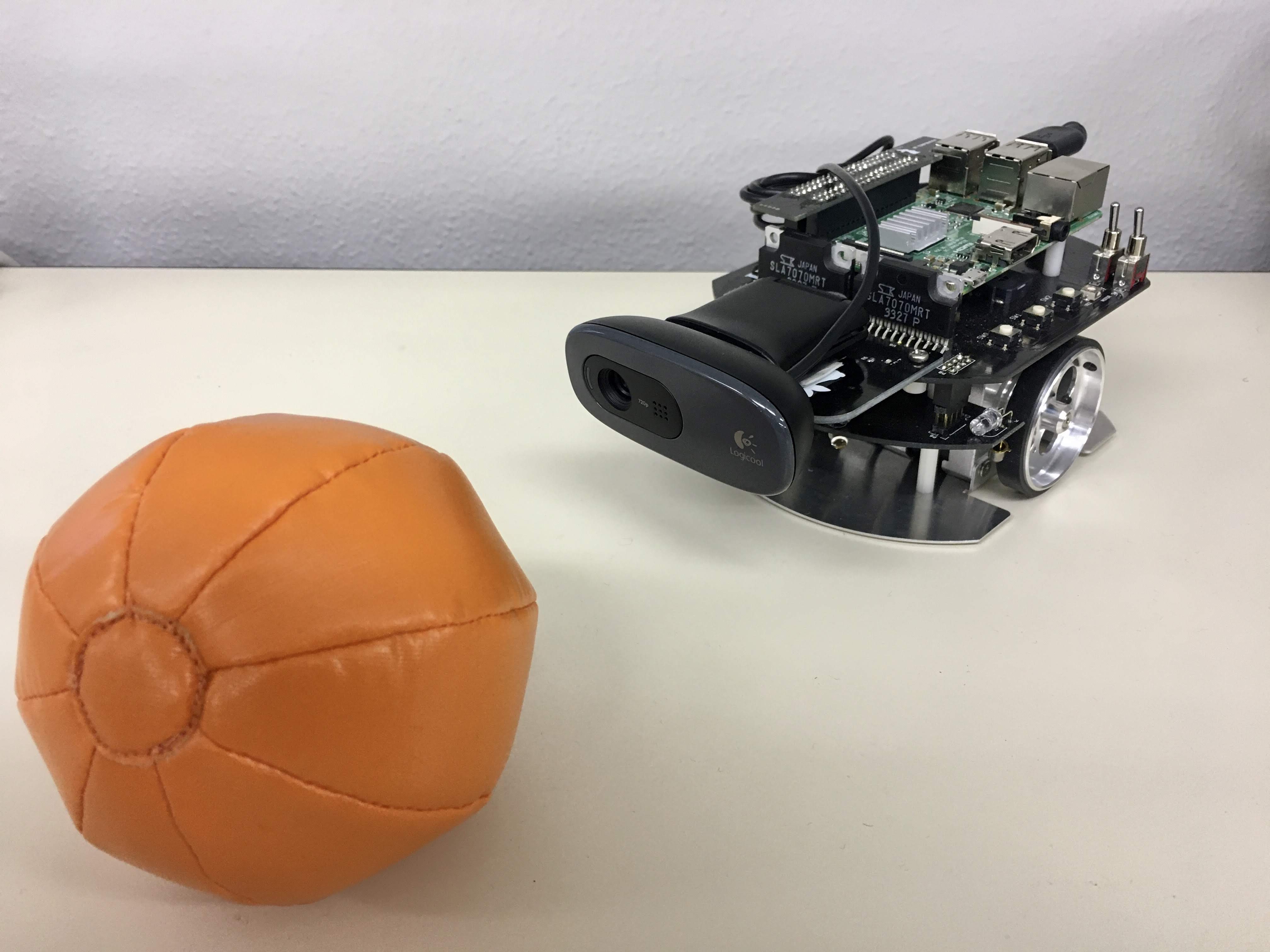 色情報をもとにオレンジ色のボールの追跡を行うコード例です。
USB接続のWebカメラとOpenCVを使ってボール追跡をします。
#### Requirements
- Webカメラ
- [Logicool HD WEBCAM C310N](https://www.logicool.co.jp/ja-jp/product/hd-webcam-c310n)
- カメラマウント
- [Raspberry Pi Mouse オプションキット No.4 \[Webカメラマウント\]](https://www.rt-shop.jp/index.php?main_page=product_info&cPath=1299_1395&products_id=3584)
- ボール(Optional)
- [ソフトボール(オレンジ)](https://www.rt-shop.jp/index.php?main_page=product_info&cPath=1299_1307&products_id=3701)
- Software
- OpenCV
- v4l-utils
#### Installation
Raspberry Pi Mouseにカメラマウントを取り付け、WebカメラをRaspberry Piに接続します。
#### How to use
次のスクリプトを実行して、カメラの自動調節機能(自動露光,オートホワイトバランス等)を切ります。
```sh
$ cd ~/ros2_ws/src/raspimouse_ros2_examples/config
$ ./configure_camera.bash
```
次のコマンドでノードを起動します。
```sh
$ ros2 launch raspimouse_ros2_examples object_tracking.launch.py video_device:=/dev/video0
```
カメラ画像は`camera/color/image_raw`、物体検出画像は`result_image`というトピックとして発行されます。
これらの画像は[RViz](https://index.ros.org/r/rviz/)
や[rqt_image_view](https://index.ros.org/p/rqt_image_view/)
で表示できます。
**画像を表示するとノードの動作が不安定になり、cmd_velや画像トピックが発行されないことがあります。**
色情報をもとにオレンジ色のボールの追跡を行うコード例です。
USB接続のWebカメラとOpenCVを使ってボール追跡をします。
#### Requirements
- Webカメラ
- [Logicool HD WEBCAM C310N](https://www.logicool.co.jp/ja-jp/product/hd-webcam-c310n)
- カメラマウント
- [Raspberry Pi Mouse オプションキット No.4 \[Webカメラマウント\]](https://www.rt-shop.jp/index.php?main_page=product_info&cPath=1299_1395&products_id=3584)
- ボール(Optional)
- [ソフトボール(オレンジ)](https://www.rt-shop.jp/index.php?main_page=product_info&cPath=1299_1307&products_id=3701)
- Software
- OpenCV
- v4l-utils
#### Installation
Raspberry Pi Mouseにカメラマウントを取り付け、WebカメラをRaspberry Piに接続します。
#### How to use
次のスクリプトを実行して、カメラの自動調節機能(自動露光,オートホワイトバランス等)を切ります。
```sh
$ cd ~/ros2_ws/src/raspimouse_ros2_examples/config
$ ./configure_camera.bash
```
次のコマンドでノードを起動します。
```sh
$ ros2 launch raspimouse_ros2_examples object_tracking.launch.py video_device:=/dev/video0
```
カメラ画像は`camera/color/image_raw`、物体検出画像は`result_image`というトピックとして発行されます。
これらの画像は[RViz](https://index.ros.org/r/rviz/)
や[rqt_image_view](https://index.ros.org/p/rqt_image_view/)
で表示できます。
**画像を表示するとノードの動作が不安定になり、cmd_velや画像トピックが発行されないことがあります。**
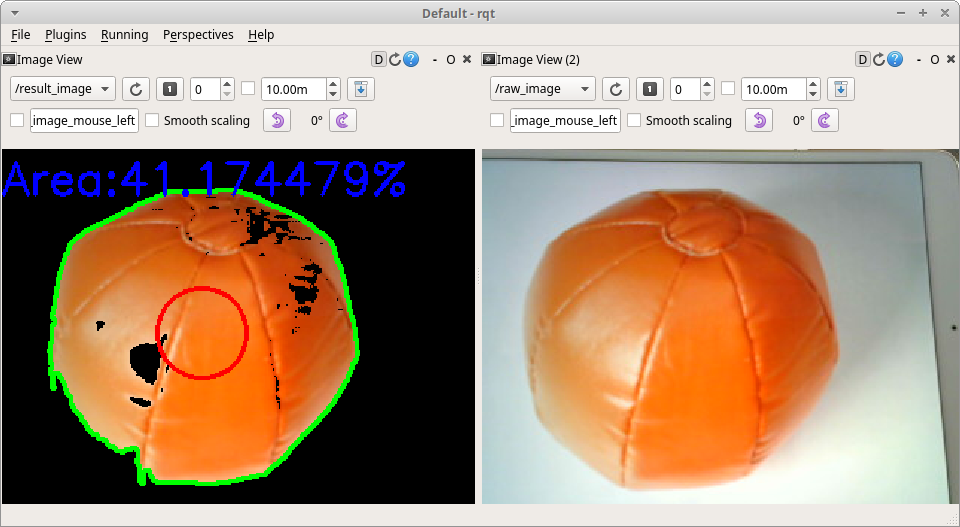 #### Configure
追跡対象の色を変更するには
[`./src/object_tracking_component.cpp`](./src/object_tracking_component.cpp)
を編集します。
物体検出精度が悪い時にはカメラの露光や関数内のパラメータを調整して下さい。
```cpp
void Tracker::tracking(const cv::Mat & input_frame, cv::Mat & result_frame)
{
cv::inRange(hsv, cv::Scalar(9, 100, 100), cv::Scalar(29, 255, 255), extracted_bin); // Orange
// cv::inRange(hsv, cv::Scalar(60, 100, 100), cv::Scalar(80, 255, 255), extracted_bin); // Green
// cv::inRange(hsv, cv::Scalar(100, 100, 100), cv::Scalar(120, 255, 255), extracted_bin); // Blue
```
#### Videos
[](https://youtu.be/8lgmSTScP98)
[back to example list](#how-to-use-examples)
---
### line_follower
#### Configure
追跡対象の色を変更するには
[`./src/object_tracking_component.cpp`](./src/object_tracking_component.cpp)
を編集します。
物体検出精度が悪い時にはカメラの露光や関数内のパラメータを調整して下さい。
```cpp
void Tracker::tracking(const cv::Mat & input_frame, cv::Mat & result_frame)
{
cv::inRange(hsv, cv::Scalar(9, 100, 100), cv::Scalar(29, 255, 255), extracted_bin); // Orange
// cv::inRange(hsv, cv::Scalar(60, 100, 100), cv::Scalar(80, 255, 255), extracted_bin); // Green
// cv::inRange(hsv, cv::Scalar(100, 100, 100), cv::Scalar(120, 255, 255), extracted_bin); // Blue
```
#### Videos
[](https://youtu.be/8lgmSTScP98)
[back to example list](#how-to-use-examples)
---
### line_follower
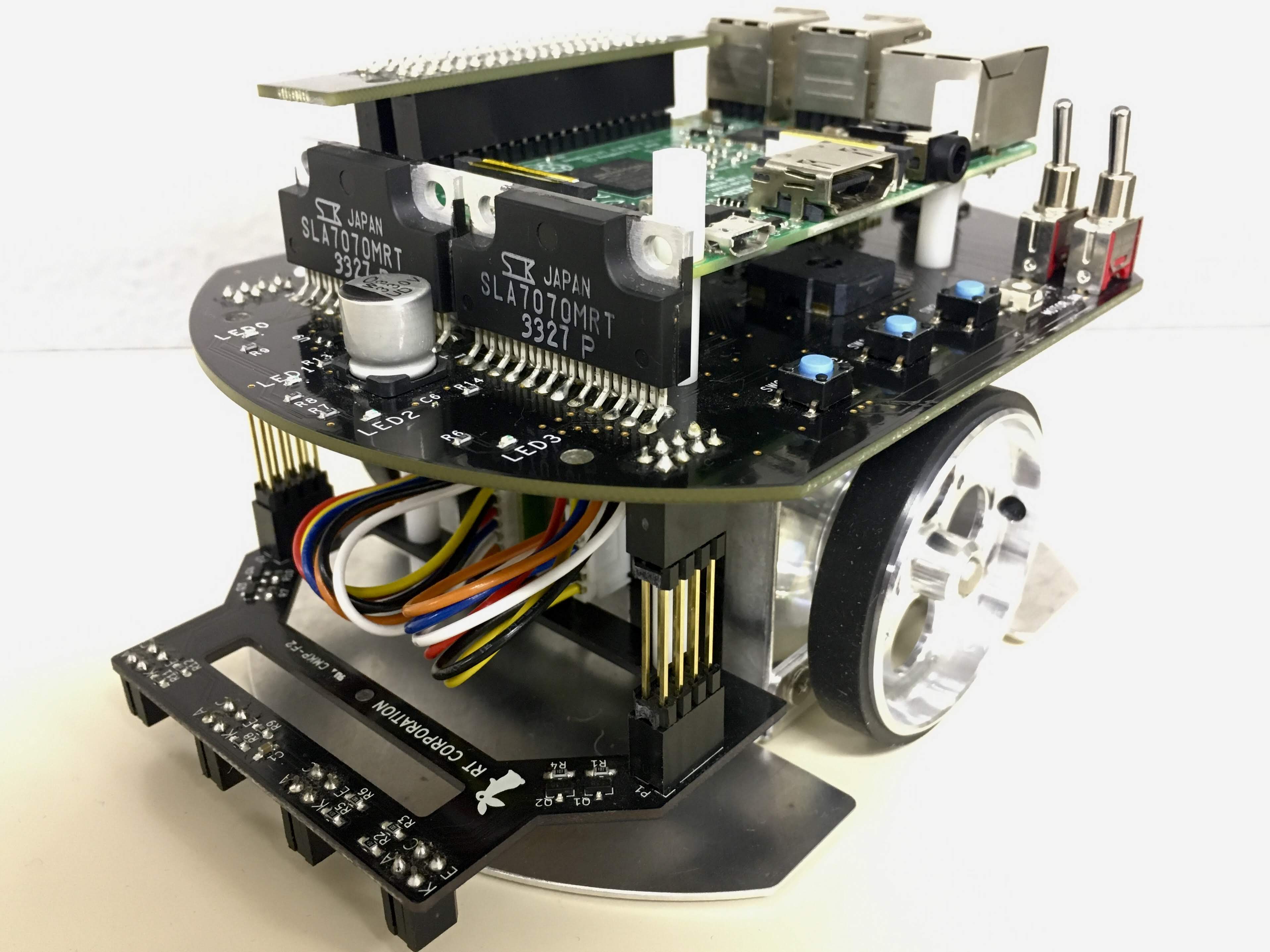 ライントレースのコード例です。
#### Requirements
- ライントレースセンサ
- [Raspberry Pi Mouse オプションキット No.3 \[ライントレース\]](https://www.rt-shop.jp/index.php?main_page=product_info&cPath=1299_1395&products_id=3591)
- フィールドとライン (Optional)
#### Installation
Raspberry Pi Mouseにライントレースセンサを取り付けます。
#### How to use
次のコマンドでノードを起動します。
```sh
$ ros2 launch raspimouse_ros2_examples line_follower.launch.py
```
Raspberry Pi Mouseをフィールドに置き、SW2を押してフィールド上のセンサ値をサンプリングします。
ライントレースのコード例です。
#### Requirements
- ライントレースセンサ
- [Raspberry Pi Mouse オプションキット No.3 \[ライントレース\]](https://www.rt-shop.jp/index.php?main_page=product_info&cPath=1299_1395&products_id=3591)
- フィールドとライン (Optional)
#### Installation
Raspberry Pi Mouseにライントレースセンサを取り付けます。
#### How to use
次のコマンドでノードを起動します。
```sh
$ ros2 launch raspimouse_ros2_examples line_follower.launch.py
```
Raspberry Pi Mouseをフィールドに置き、SW2を押してフィールド上のセンサ値をサンプリングします。
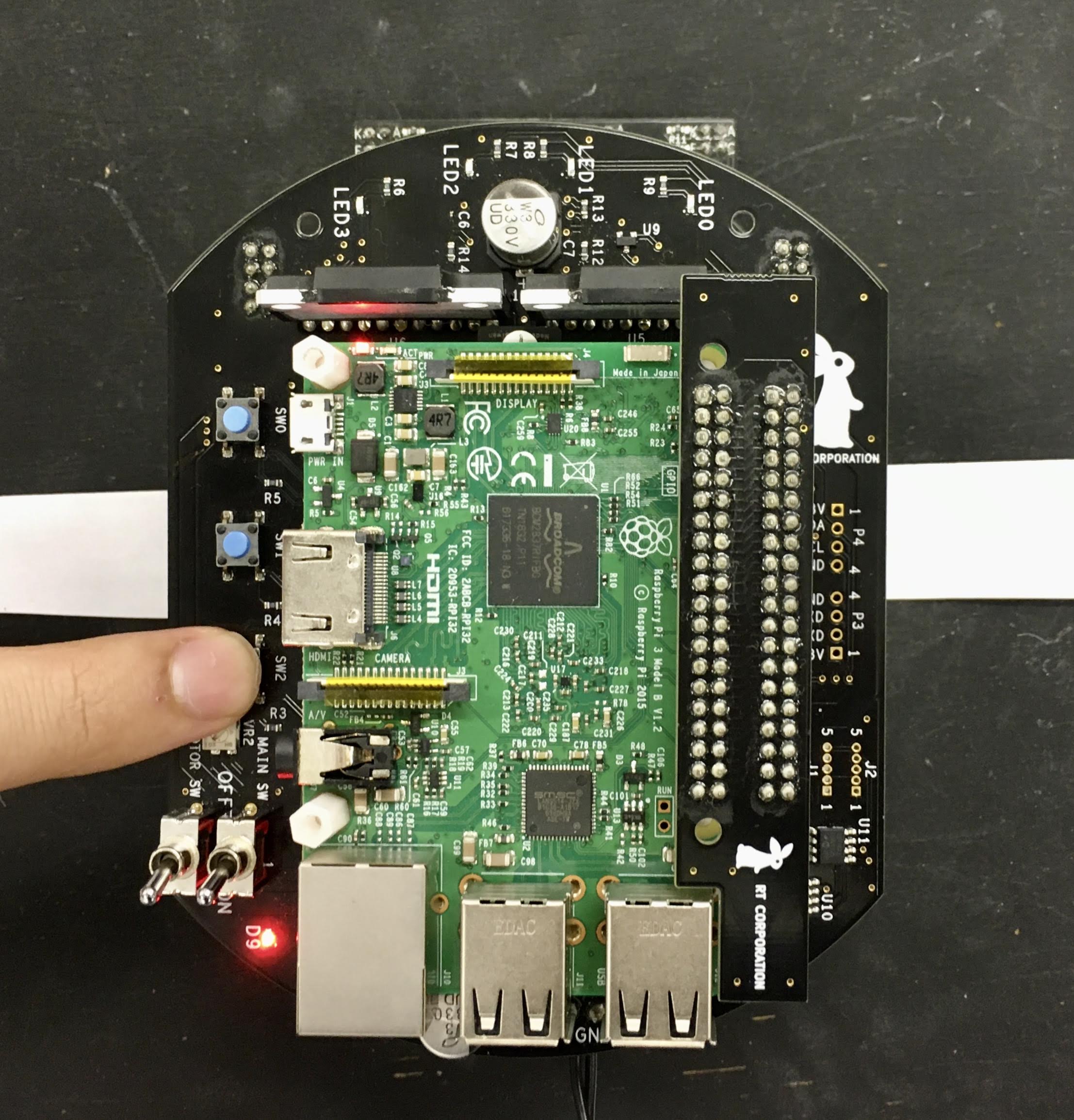 次に、センサとラインが重なるようにRaspberry Pi Mouseを置き、SW1を押してライン上のセンサ値をサンプリングします。
次に、センサとラインが重なるようにRaspberry Pi Mouseを置き、SW1を押してライン上のセンサ値をサンプリングします。
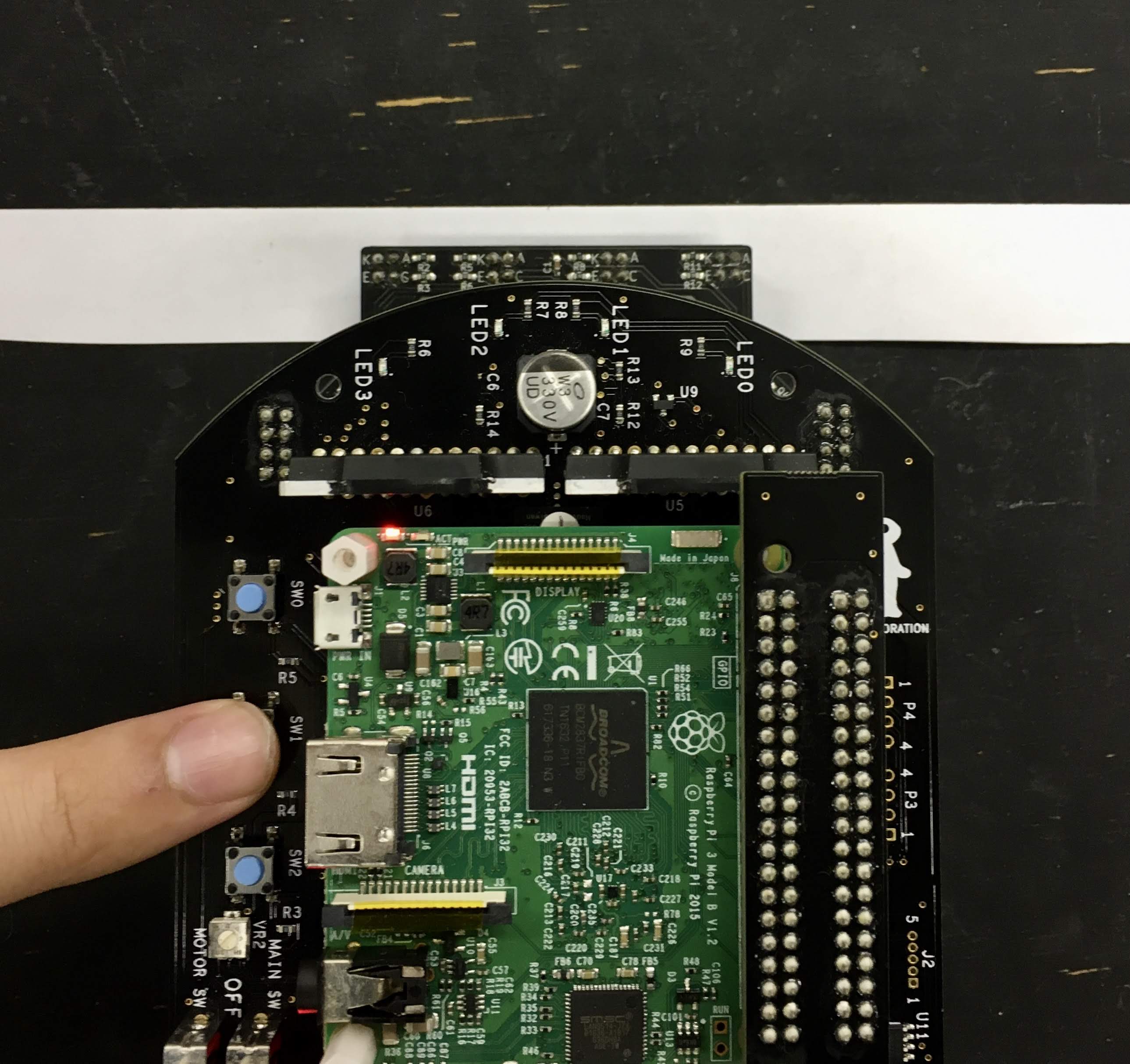 最後に、ライン上にRaspberry Pi Mouseを置き、SW0を押してライントレースを開始します。
最後に、ライン上にRaspberry Pi Mouseを置き、SW0を押してライントレースを開始します。
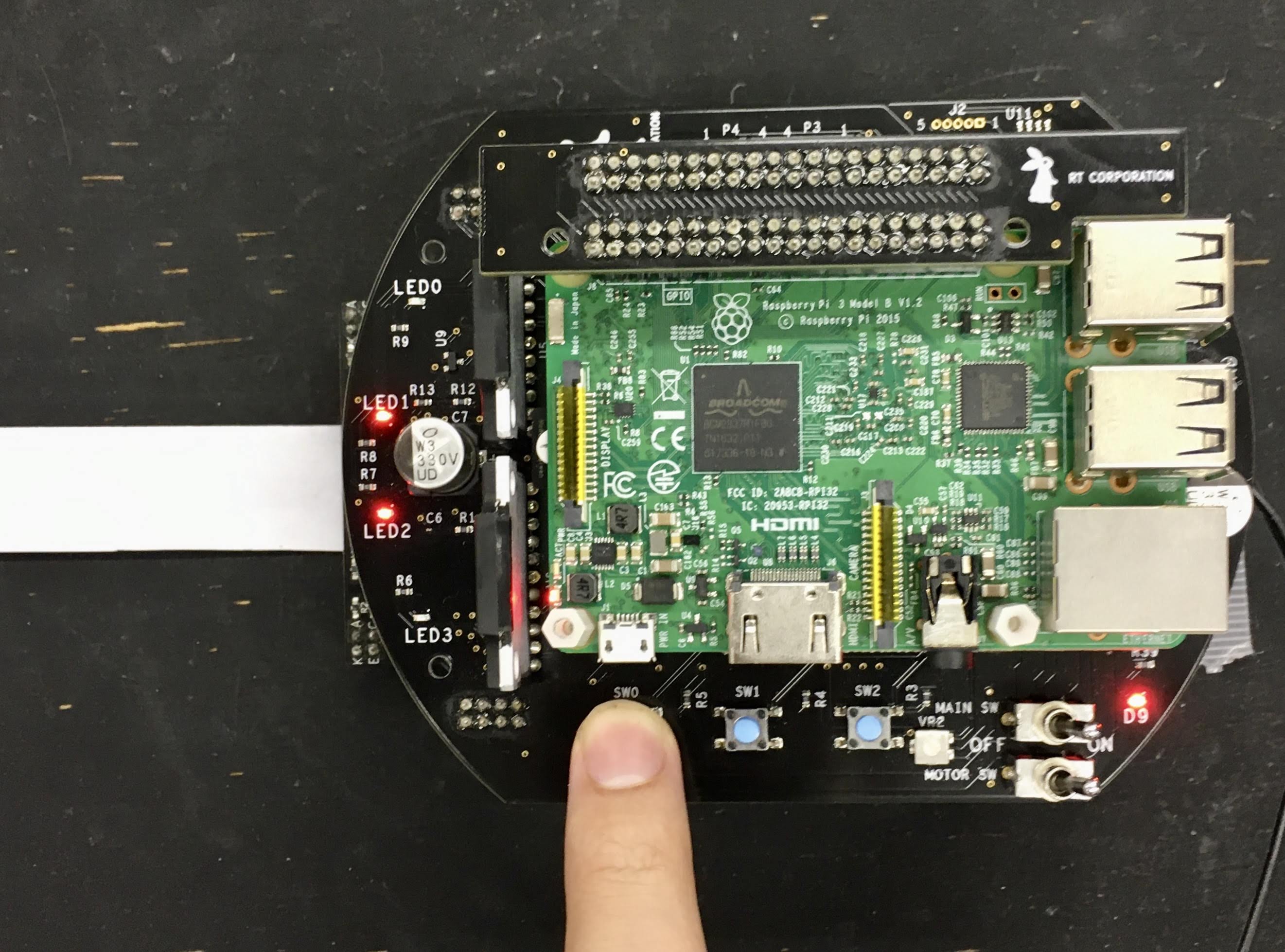 もう一度SW0を押すとライントレースを停止します。
#### Configure
走行速度を変更するには[`./src/line_follower_component.cpp`](./src/line_follower_component.cpp)を編集します。
```cpp
void Follower::publish_cmdvel_for_line_following(void)
{
const double VEL_LINEAR_X = 0.08; // m/s
const double VEL_ANGULAR_Z = 0.8; // rad/s
const double LOW_VEL_ANGULAR_Z = 0.5; // rad/s
```
#### Videos
[](https://youtu.be/oPm0sW2V_tY)
[back to example list](#how-to-use-examples)
---
### camera_line_follower
もう一度SW0を押すとライントレースを停止します。
#### Configure
走行速度を変更するには[`./src/line_follower_component.cpp`](./src/line_follower_component.cpp)を編集します。
```cpp
void Follower::publish_cmdvel_for_line_following(void)
{
const double VEL_LINEAR_X = 0.08; // m/s
const double VEL_ANGULAR_Z = 0.8; // rad/s
const double LOW_VEL_ANGULAR_Z = 0.5; // rad/s
```
#### Videos
[](https://youtu.be/oPm0sW2V_tY)
[back to example list](#how-to-use-examples)
---
### camera_line_follower
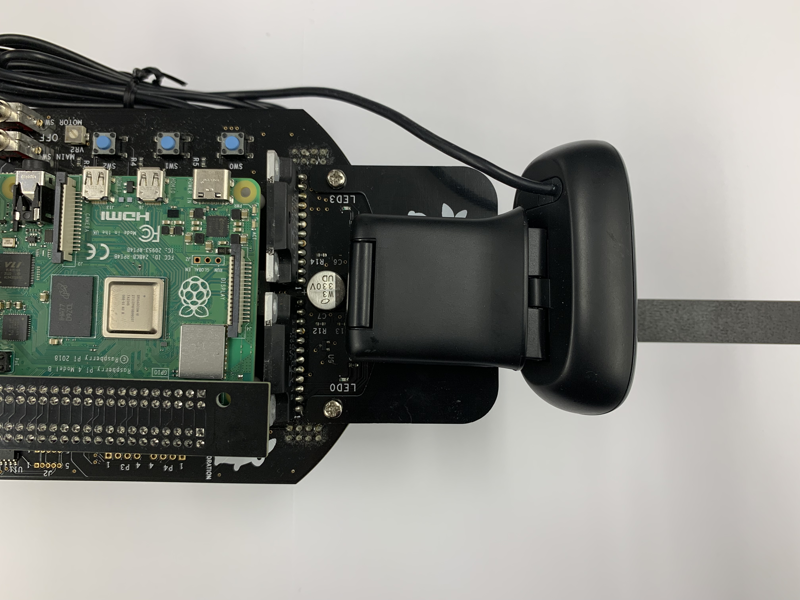 RGBカメラによるライントレースのコード例です。
#### Requirements
- Webカメラ
- [Logicool HD WEBCAM C310N](https://www.logicool.co.jp/ja-jp/product/hd-webcam-c310n)
- カメラマウント
- [Raspberry Pi Mouse オプションキット No.4 \[Webカメラマウント\]](https://www.rt-shop.jp/index.php?main_page=product_info&cPath=1299_1395&products_id=3584)
#### Installation
Raspberry Pi Mouseにカメラマウントを取り付け、WebカメラをRaspberry Piに接続します。
#### How to use
次のコマンドでノードを起動します。
```sh
$ ros2 launch raspimouse_ros2_examples camera_line_follower.launch.py video_device:=/dev/video0
```
ライン上にRaspberry Pi Mouseを置き、SW2を押してライントレースを開始します。
停止させる場合はSW0を押します。
カメラ画像は`camera/color/image_raw`、物体検出画像は`result_image`というトピックとして発行されます。
これらの画像は[RViz](https://index.ros.org/r/rviz/)
や[rqt_image_view](https://index.ros.org/p/rqt_image_view/)
で表示できます。
**画像を表示するとノードの動作が不安定になり、cmd_velや画像トピックが発行されないことがあります。**
**ラインの検出精度が悪い場合はカメラの露光やホワイトバランスの調整を行ってください。**
RGBカメラによるライントレースのコード例です。
#### Requirements
- Webカメラ
- [Logicool HD WEBCAM C310N](https://www.logicool.co.jp/ja-jp/product/hd-webcam-c310n)
- カメラマウント
- [Raspberry Pi Mouse オプションキット No.4 \[Webカメラマウント\]](https://www.rt-shop.jp/index.php?main_page=product_info&cPath=1299_1395&products_id=3584)
#### Installation
Raspberry Pi Mouseにカメラマウントを取り付け、WebカメラをRaspberry Piに接続します。
#### How to use
次のコマンドでノードを起動します。
```sh
$ ros2 launch raspimouse_ros2_examples camera_line_follower.launch.py video_device:=/dev/video0
```
ライン上にRaspberry Pi Mouseを置き、SW2を押してライントレースを開始します。
停止させる場合はSW0を押します。
カメラ画像は`camera/color/image_raw`、物体検出画像は`result_image`というトピックとして発行されます。
これらの画像は[RViz](https://index.ros.org/r/rviz/)
や[rqt_image_view](https://index.ros.org/p/rqt_image_view/)
で表示できます。
**画像を表示するとノードの動作が不安定になり、cmd_velや画像トピックが発行されないことがあります。**
**ラインの検出精度が悪い場合はカメラの露光やホワイトバランスの調整を行ってください。**
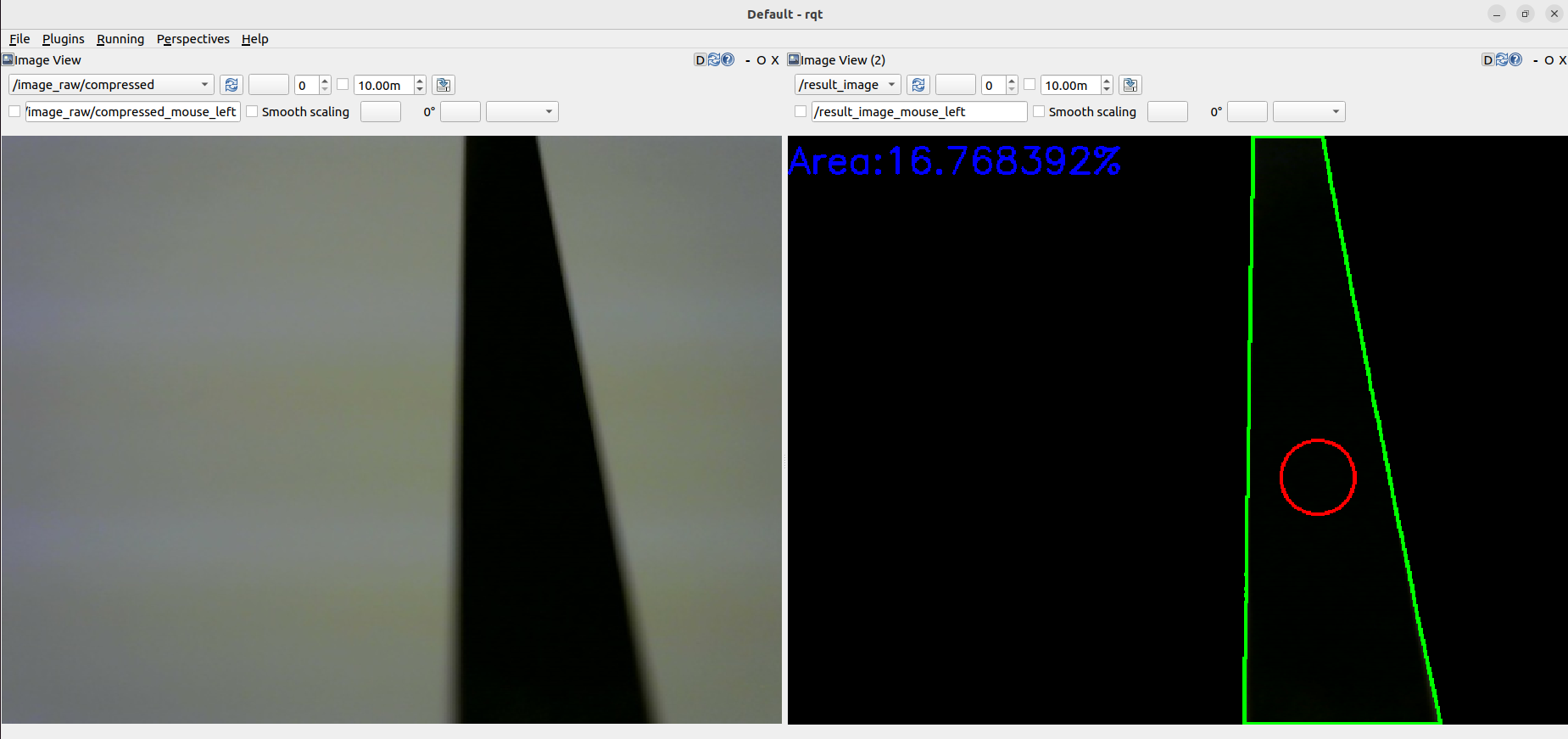 #### Parameters
- `max_brightness`
- Type: `int`
- Default: 90
- 画像の2値化のしきい値の最大値
- `min_brightness`
- Type: `int`
- Default: 0
- 画像の2値化のしきい値の最小値
- `max_linear_vel`
- Type: `double`
- Default: 0.05
- 直進速度の最大値
- `max_angular_vel`
- Type: `double`
- Default: 0.8
- 旋回速度の最大値
- `area_threshold`
- Type: `double`
- Default: 0.20
- 走行を開始するためのライン面積のしきい値
```sh
ros2 param set /camera_follower max_brightness 80
```
[back to example list](#how-to-use-examples)
---
### SLAM
#### Parameters
- `max_brightness`
- Type: `int`
- Default: 90
- 画像の2値化のしきい値の最大値
- `min_brightness`
- Type: `int`
- Default: 0
- 画像の2値化のしきい値の最小値
- `max_linear_vel`
- Type: `double`
- Default: 0.05
- 直進速度の最大値
- `max_angular_vel`
- Type: `double`
- Default: 0.8
- 旋回速度の最大値
- `area_threshold`
- Type: `double`
- Default: 0.20
- 走行を開始するためのライン面積のしきい値
```sh
ros2 param set /camera_follower max_brightness 80
```
[back to example list](#how-to-use-examples)
---
### SLAM
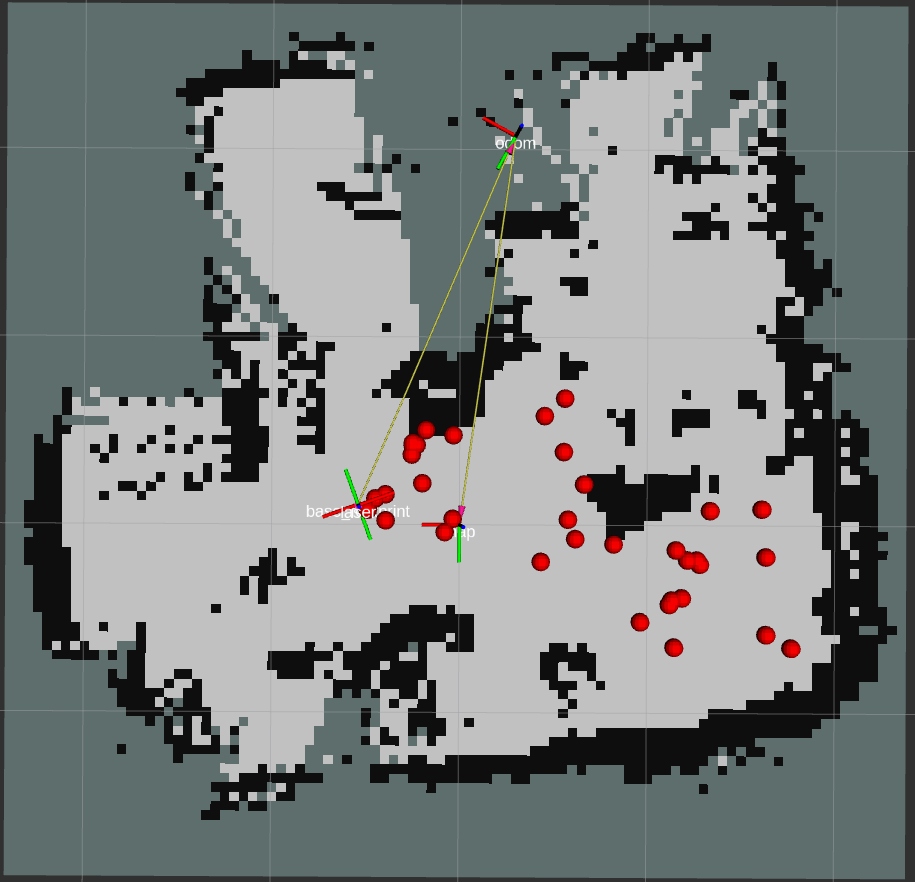 Raspberry Pi MouseでSLAMとNavigationを行うサンプルは[rt-net/raspimouse_slam_navigation_ros2](https://github.com/rt-net/raspimouse_slam_navigation_ros2)へ移行しました。
[back to example list](#how-to-use-examples)
---
### direction_controller
Raspberry Pi MouseでSLAMとNavigationを行うサンプルは[rt-net/raspimouse_slam_navigation_ros2](https://github.com/rt-net/raspimouse_slam_navigation_ros2)へ移行しました。
[back to example list](#how-to-use-examples)
---
### direction_controller

 IMUセンサを使用した角度制御のコード例です。
#### Requirements
- [USB出力9軸IMUセンサモジュール](https://www.rt-shop.jp/index.php?main_page=product_info&cPath=1348_1&products_id=3416&language=ja)
- LiDAR Mount ([Raspberry Pi Mouse オプションキットNo.8 [マルチLiDARマウント]](https://www.rt-shop.jp/index.php?main_page=product_info&cPath=1299_1395&products_id=3867))
- RT-USB-9axisIMU ROS Package
- https://github.com/rt-net/rt_usb_9axisimu_driver
#### Installation
LiDAR MountにIMUセンサモジュールを取り付けます。
IMUセンサを使用した角度制御のコード例です。
#### Requirements
- [USB出力9軸IMUセンサモジュール](https://www.rt-shop.jp/index.php?main_page=product_info&cPath=1348_1&products_id=3416&language=ja)
- LiDAR Mount ([Raspberry Pi Mouse オプションキットNo.8 [マルチLiDARマウント]](https://www.rt-shop.jp/index.php?main_page=product_info&cPath=1299_1395&products_id=3867))
- RT-USB-9axisIMU ROS Package
- https://github.com/rt-net/rt_usb_9axisimu_driver
#### Installation
LiDAR MountにIMUセンサモジュールを取り付けます。
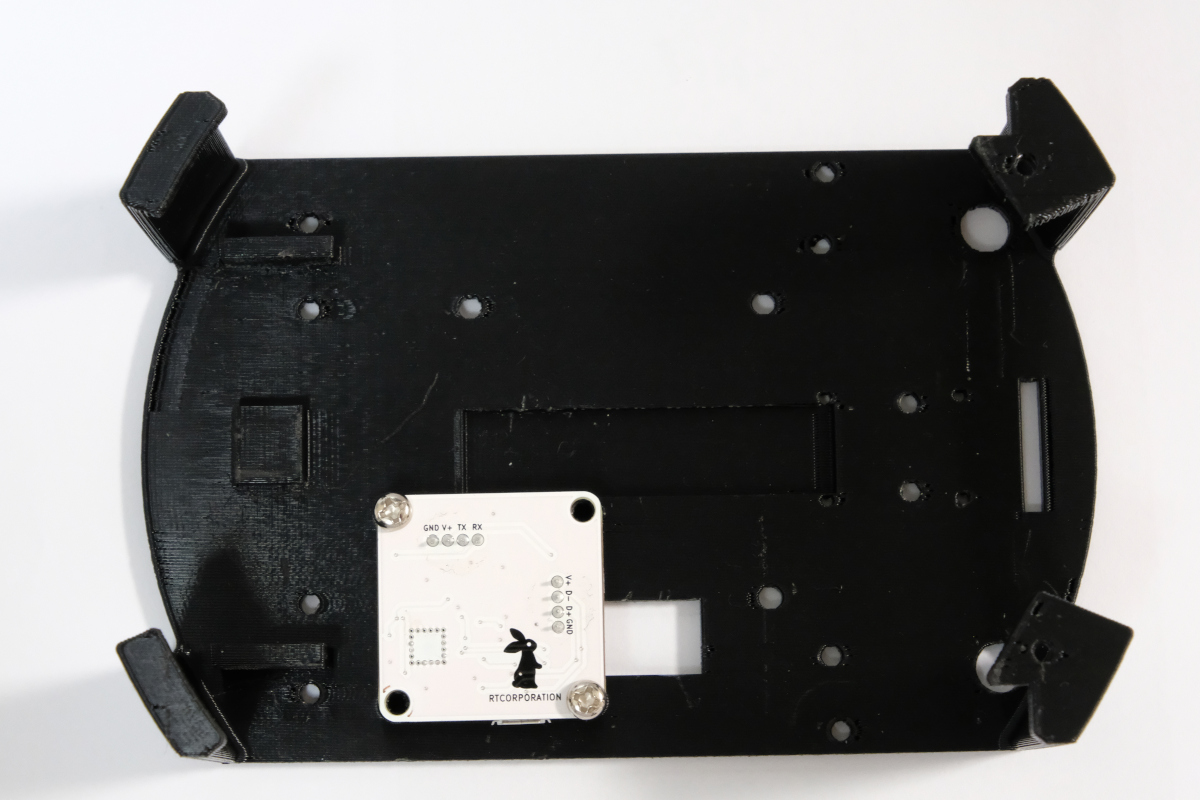 Raspberry Pi Mouse にLiDAR Mountを取り付けます。
Raspberry Pi Mouse にLiDAR Mountを取り付けます。
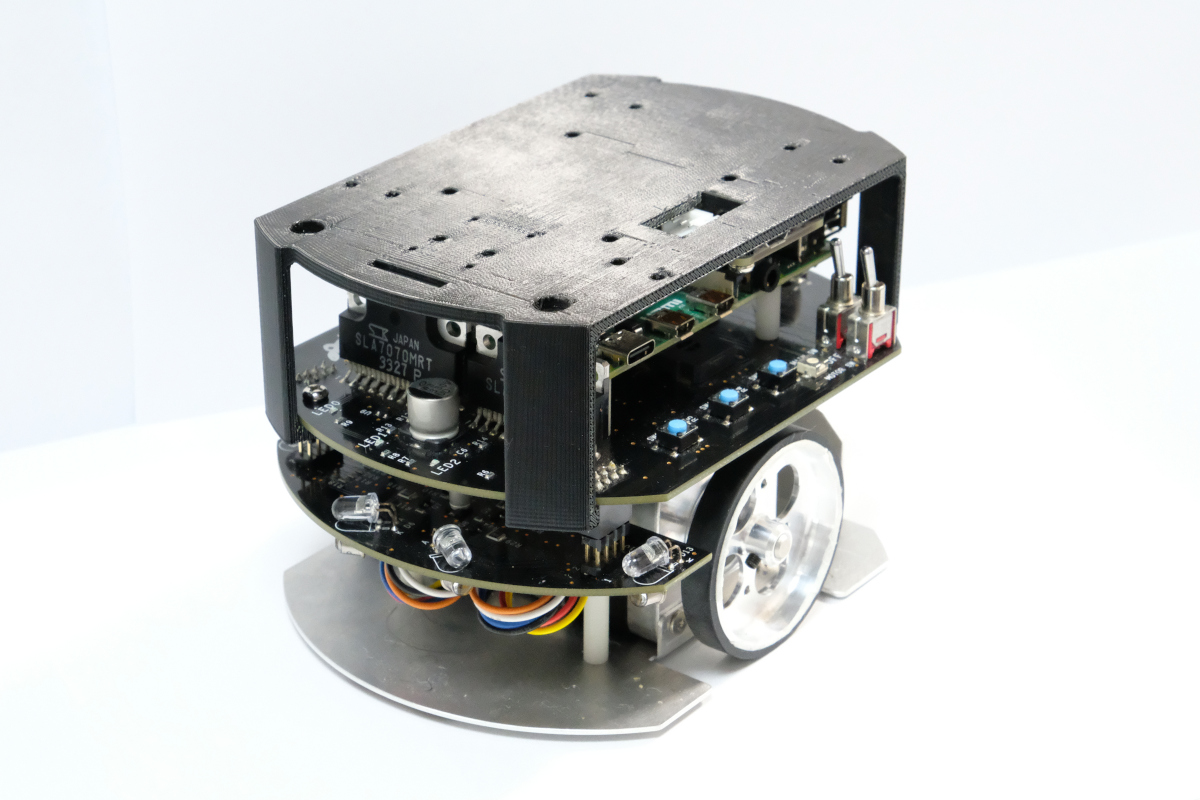 #### How to use
次のコマンドでノードを起動します。
```sh
$ ros2 launch raspimouse_ros2_examples direction_controller.launch.py
```
SW0 ~ SW2を押して動作モードを切り替えます。
- SW0: ジャイロセンサのバイアスをキャリブレーションし、ラズパイマウスの方位角を`0 rad`にリセットします
- SW1: 方位角を`0 rad`に維持する角度制御を開始します
- SW0 ~ SW2を押すか、ラズパイマウス本体を横に傾けると終了します
- SW2: 方位角を`-π ~ π rad`に変化させる角度制御を開始します
- SW0 ~ SW2を押すか、ラズパイマウス本体を横に傾けると終了します
### Troubleshooting
IMUの接続が正常に行われない場合があります。
その時は、IMUのUSBケーブルを抜き差ししてください。
抜き差し実施後は、コマンドを再度実行してください。
#### Configure
パラメータで角度制御に使うPIDゲインを変更できます。
```sh
$ ros2 param set /direction_controller p_gain 10.0
Set parameter successful
$ ros2 param set /direction_controller i_gain 0.5
Set parameter successful
$ ros2 param set /direction_controller d_gain 0.0
Set parameter successful
```
#### Parameters
- p_gain
- Proportional gain of a PID controller for the direction control
- default: 10.0, min:0.0, max:30.0
- type: double
- i_gain
- Integral gain of a PID controller for the direction control
- default: 0.0, min:0.0, max:5.0
- type: double
- d_gain
- Derivative gain of a PID controller for the direction control
- default: 20.0, min:0.0, max:30.0
- type: double
- target_angle
- Target angle for the SW1 control mode.
- default: 0.0, min:-π, max:+π
- type: double
#### Publish topics
- heading_angle
- Heading angle of the robot that calculated from the IMU module sensor values.
- type: std_msgs/Float64
#### Videos
[](https://youtu.be/ghcCYOh9_MM)
[back to example list](#how-to-use-examples)
#### How to use
次のコマンドでノードを起動します。
```sh
$ ros2 launch raspimouse_ros2_examples direction_controller.launch.py
```
SW0 ~ SW2を押して動作モードを切り替えます。
- SW0: ジャイロセンサのバイアスをキャリブレーションし、ラズパイマウスの方位角を`0 rad`にリセットします
- SW1: 方位角を`0 rad`に維持する角度制御を開始します
- SW0 ~ SW2を押すか、ラズパイマウス本体を横に傾けると終了します
- SW2: 方位角を`-π ~ π rad`に変化させる角度制御を開始します
- SW0 ~ SW2を押すか、ラズパイマウス本体を横に傾けると終了します
### Troubleshooting
IMUの接続が正常に行われない場合があります。
その時は、IMUのUSBケーブルを抜き差ししてください。
抜き差し実施後は、コマンドを再度実行してください。
#### Configure
パラメータで角度制御に使うPIDゲインを変更できます。
```sh
$ ros2 param set /direction_controller p_gain 10.0
Set parameter successful
$ ros2 param set /direction_controller i_gain 0.5
Set parameter successful
$ ros2 param set /direction_controller d_gain 0.0
Set parameter successful
```
#### Parameters
- p_gain
- Proportional gain of a PID controller for the direction control
- default: 10.0, min:0.0, max:30.0
- type: double
- i_gain
- Integral gain of a PID controller for the direction control
- default: 0.0, min:0.0, max:5.0
- type: double
- d_gain
- Derivative gain of a PID controller for the direction control
- default: 20.0, min:0.0, max:30.0
- type: double
- target_angle
- Target angle for the SW1 control mode.
- default: 0.0, min:-π, max:+π
- type: double
#### Publish topics
- heading_angle
- Heading angle of the robot that calculated from the IMU module sensor values.
- type: std_msgs/Float64
#### Videos
[](https://youtu.be/ghcCYOh9_MM)
[back to example list](#how-to-use-examples)
 ## Supported ROS 2 distributions
- [Humble](https://github.com/rt-net/raspimouse_ros2_examples/tree/humble)
- [Jazzy](https://github.com/rt-net/raspimouse_ros2_examples/tree/jazzy) (This branch)
## Requirements
- Raspberry Pi Mouse
- https://rt-net.jp/products/raspberrypimousev3/
- Linux OS
- Ubuntu server 24.04
- Device Driver
- [rt-net/RaspberryPiMouse](https://github.com/rt-net/RaspberryPiMouse)
- ROS
- [Jazzy Jalisco](https://docs.ros.org/en/jazzy/index.html)
- Raspberry Pi Mouse ROS 2 package
- https://github.com/rt-net/raspimouse2
- Remote Computer (Optional)
- ROS
- [Jazzy Jalisco](https://docs.ros.org/en/jazzy/index.html)
- Raspberry Pi Mouse ROS 2 package
- https://github.com/rt-net/raspimouse2
## Installation
```sh
$ cd ~/ros2_ws/src
# Clone package
$ git clone -b $ROS_DISTRO https://github.com/rt-net/raspimouse_ros2_examples.git
# Install dependencies
$ rosdep install -r -y --from-paths . --ignore-src
# Build & Install
$ cd ~/ros2_ws
$ colcon build --symlink-install
$ source ~/ros2_ws/install/setup.bash
```
## License
このリポジトリはApache 2.0ライセンスの元、公開されています。
ライセンスについては[LICENSE](./LICENSE)を参照ください。
## How To Use Examples
- [joystick_control](#joystick_control)
- [object_tracking](#object_tracking)
- [line_follower](#line_follower)
- [camera_line_follower](#camera_line_follower)
- [SLAM](#slam)
- [direction_controller](#direction_controller)
---
### joystick_control
ジョイスティックコントローラでRaspberryPiMouseを動かすコード例です。
#### Requirements
- Joystick Controller
- [Logicool Wireless Gamepad F710](https://gaming.logicool.co.jp/ja-jp/products/gamepads/f710-wireless-gamepad.html#940-0001440)
- [SONY DUALSHOCK 3](https://www.jp.playstation.com/ps3/peripheral/cechzc2j.html)
#### How to use
次のコマンドでノードを起動します。
```sh
# Use F710
$ ros2 launch raspimouse_ros2_examples teleop_joy.launch.py joydev:="/dev/input/js0" joyconfig:=f710 mouse:=true
# Use DUALSHOCK 3
$ ros2 launch raspimouse_ros2_examples teleop_joy.launch.py joydev:="/dev/input/js0" joyconfig:=dualshock3 mouse:=true
# Control from remote computer
## on RaspberryPiMouse
$ ros2 run raspimouse raspimouse
## on remote computer
$ ros2 launch raspimouse_ros2_examples teleop_joy.launch.py mouse:=false
```
デフォルトのキー割り当てはこちらです。
Logicool Wireless Gamepad F710を使う場合はモード切替スイッチを __D__ (DirectInput Mode)に設定します。

#### Configure
[./config/joy_f710.yml](./config/joy_f710.yml)、[./config/joy_dualshock3.yml](./config/joy_dualshock3.yml)
のキー番号を編集することで、キー割り当てを変更できます。
```yaml
button_shutdown_1 : 8
button_shutdown_2 : 9
button_motor_off : 8
button_motor_on : 9
button_cmd_enable : 4
```
#### Videos
[](https://youtu.be/GswxdB8Ia0Y)
[back to example list](#how-to-use-examples)
---
### object_tracking
## Supported ROS 2 distributions
- [Humble](https://github.com/rt-net/raspimouse_ros2_examples/tree/humble)
- [Jazzy](https://github.com/rt-net/raspimouse_ros2_examples/tree/jazzy) (This branch)
## Requirements
- Raspberry Pi Mouse
- https://rt-net.jp/products/raspberrypimousev3/
- Linux OS
- Ubuntu server 24.04
- Device Driver
- [rt-net/RaspberryPiMouse](https://github.com/rt-net/RaspberryPiMouse)
- ROS
- [Jazzy Jalisco](https://docs.ros.org/en/jazzy/index.html)
- Raspberry Pi Mouse ROS 2 package
- https://github.com/rt-net/raspimouse2
- Remote Computer (Optional)
- ROS
- [Jazzy Jalisco](https://docs.ros.org/en/jazzy/index.html)
- Raspberry Pi Mouse ROS 2 package
- https://github.com/rt-net/raspimouse2
## Installation
```sh
$ cd ~/ros2_ws/src
# Clone package
$ git clone -b $ROS_DISTRO https://github.com/rt-net/raspimouse_ros2_examples.git
# Install dependencies
$ rosdep install -r -y --from-paths . --ignore-src
# Build & Install
$ cd ~/ros2_ws
$ colcon build --symlink-install
$ source ~/ros2_ws/install/setup.bash
```
## License
このリポジトリはApache 2.0ライセンスの元、公開されています。
ライセンスについては[LICENSE](./LICENSE)を参照ください。
## How To Use Examples
- [joystick_control](#joystick_control)
- [object_tracking](#object_tracking)
- [line_follower](#line_follower)
- [camera_line_follower](#camera_line_follower)
- [SLAM](#slam)
- [direction_controller](#direction_controller)
---
### joystick_control
ジョイスティックコントローラでRaspberryPiMouseを動かすコード例です。
#### Requirements
- Joystick Controller
- [Logicool Wireless Gamepad F710](https://gaming.logicool.co.jp/ja-jp/products/gamepads/f710-wireless-gamepad.html#940-0001440)
- [SONY DUALSHOCK 3](https://www.jp.playstation.com/ps3/peripheral/cechzc2j.html)
#### How to use
次のコマンドでノードを起動します。
```sh
# Use F710
$ ros2 launch raspimouse_ros2_examples teleop_joy.launch.py joydev:="/dev/input/js0" joyconfig:=f710 mouse:=true
# Use DUALSHOCK 3
$ ros2 launch raspimouse_ros2_examples teleop_joy.launch.py joydev:="/dev/input/js0" joyconfig:=dualshock3 mouse:=true
# Control from remote computer
## on RaspberryPiMouse
$ ros2 run raspimouse raspimouse
## on remote computer
$ ros2 launch raspimouse_ros2_examples teleop_joy.launch.py mouse:=false
```
デフォルトのキー割り当てはこちらです。
Logicool Wireless Gamepad F710を使う場合はモード切替スイッチを __D__ (DirectInput Mode)に設定します。

#### Configure
[./config/joy_f710.yml](./config/joy_f710.yml)、[./config/joy_dualshock3.yml](./config/joy_dualshock3.yml)
のキー番号を編集することで、キー割り当てを変更できます。
```yaml
button_shutdown_1 : 8
button_shutdown_2 : 9
button_motor_off : 8
button_motor_on : 9
button_cmd_enable : 4
```
#### Videos
[](https://youtu.be/GswxdB8Ia0Y)
[back to example list](#how-to-use-examples)
---
### object_tracking
 ライントレースのコード例です。
#### Requirements
- ライントレースセンサ
- [Raspberry Pi Mouse オプションキット No.3 \[ライントレース\]](https://www.rt-shop.jp/index.php?main_page=product_info&cPath=1299_1395&products_id=3591)
- フィールドとライン (Optional)
#### Installation
Raspberry Pi Mouseにライントレースセンサを取り付けます。
#### How to use
次のコマンドでノードを起動します。
```sh
$ ros2 launch raspimouse_ros2_examples line_follower.launch.py
```
Raspberry Pi Mouseをフィールドに置き、SW2を押してフィールド上のセンサ値をサンプリングします。
ライントレースのコード例です。
#### Requirements
- ライントレースセンサ
- [Raspberry Pi Mouse オプションキット No.3 \[ライントレース\]](https://www.rt-shop.jp/index.php?main_page=product_info&cPath=1299_1395&products_id=3591)
- フィールドとライン (Optional)
#### Installation
Raspberry Pi Mouseにライントレースセンサを取り付けます。
#### How to use
次のコマンドでノードを起動します。
```sh
$ ros2 launch raspimouse_ros2_examples line_follower.launch.py
```
Raspberry Pi Mouseをフィールドに置き、SW2を押してフィールド上のセンサ値をサンプリングします。
 次に、センサとラインが重なるようにRaspberry Pi Mouseを置き、SW1を押してライン上のセンサ値をサンプリングします。
次に、センサとラインが重なるようにRaspberry Pi Mouseを置き、SW1を押してライン上のセンサ値をサンプリングします。
 最後に、ライン上にRaspberry Pi Mouseを置き、SW0を押してライントレースを開始します。
最後に、ライン上にRaspberry Pi Mouseを置き、SW0を押してライントレースを開始します。
 もう一度SW0を押すとライントレースを停止します。
#### Configure
走行速度を変更するには[`./src/line_follower_component.cpp`](./src/line_follower_component.cpp)を編集します。
```cpp
void Follower::publish_cmdvel_for_line_following(void)
{
const double VEL_LINEAR_X = 0.08; // m/s
const double VEL_ANGULAR_Z = 0.8; // rad/s
const double LOW_VEL_ANGULAR_Z = 0.5; // rad/s
```
#### Videos
[](https://youtu.be/oPm0sW2V_tY)
[back to example list](#how-to-use-examples)
---
### camera_line_follower
もう一度SW0を押すとライントレースを停止します。
#### Configure
走行速度を変更するには[`./src/line_follower_component.cpp`](./src/line_follower_component.cpp)を編集します。
```cpp
void Follower::publish_cmdvel_for_line_following(void)
{
const double VEL_LINEAR_X = 0.08; // m/s
const double VEL_ANGULAR_Z = 0.8; // rad/s
const double LOW_VEL_ANGULAR_Z = 0.5; // rad/s
```
#### Videos
[](https://youtu.be/oPm0sW2V_tY)
[back to example list](#how-to-use-examples)
---
### camera_line_follower
 RGBカメラによるライントレースのコード例です。
#### Requirements
- Webカメラ
- [Logicool HD WEBCAM C310N](https://www.logicool.co.jp/ja-jp/product/hd-webcam-c310n)
- カメラマウント
- [Raspberry Pi Mouse オプションキット No.4 \[Webカメラマウント\]](https://www.rt-shop.jp/index.php?main_page=product_info&cPath=1299_1395&products_id=3584)
#### Installation
Raspberry Pi Mouseにカメラマウントを取り付け、WebカメラをRaspberry Piに接続します。
#### How to use
次のコマンドでノードを起動します。
```sh
$ ros2 launch raspimouse_ros2_examples camera_line_follower.launch.py video_device:=/dev/video0
```
ライン上にRaspberry Pi Mouseを置き、SW2を押してライントレースを開始します。
停止させる場合はSW0を押します。
カメラ画像は`camera/color/image_raw`、物体検出画像は`result_image`というトピックとして発行されます。
これらの画像は[RViz](https://index.ros.org/r/rviz/)
や[rqt_image_view](https://index.ros.org/p/rqt_image_view/)
で表示できます。
**画像を表示するとノードの動作が不安定になり、cmd_velや画像トピックが発行されないことがあります。**
**ラインの検出精度が悪い場合はカメラの露光やホワイトバランスの調整を行ってください。**
RGBカメラによるライントレースのコード例です。
#### Requirements
- Webカメラ
- [Logicool HD WEBCAM C310N](https://www.logicool.co.jp/ja-jp/product/hd-webcam-c310n)
- カメラマウント
- [Raspberry Pi Mouse オプションキット No.4 \[Webカメラマウント\]](https://www.rt-shop.jp/index.php?main_page=product_info&cPath=1299_1395&products_id=3584)
#### Installation
Raspberry Pi Mouseにカメラマウントを取り付け、WebカメラをRaspberry Piに接続します。
#### How to use
次のコマンドでノードを起動します。
```sh
$ ros2 launch raspimouse_ros2_examples camera_line_follower.launch.py video_device:=/dev/video0
```
ライン上にRaspberry Pi Mouseを置き、SW2を押してライントレースを開始します。
停止させる場合はSW0を押します。
カメラ画像は`camera/color/image_raw`、物体検出画像は`result_image`というトピックとして発行されます。
これらの画像は[RViz](https://index.ros.org/r/rviz/)
や[rqt_image_view](https://index.ros.org/p/rqt_image_view/)
で表示できます。
**画像を表示するとノードの動作が不安定になり、cmd_velや画像トピックが発行されないことがあります。**
**ラインの検出精度が悪い場合はカメラの露光やホワイトバランスの調整を行ってください。**
 #### Parameters
- `max_brightness`
- Type: `int`
- Default: 90
- 画像の2値化のしきい値の最大値
- `min_brightness`
- Type: `int`
- Default: 0
- 画像の2値化のしきい値の最小値
- `max_linear_vel`
- Type: `double`
- Default: 0.05
- 直進速度の最大値
- `max_angular_vel`
- Type: `double`
- Default: 0.8
- 旋回速度の最大値
- `area_threshold`
- Type: `double`
- Default: 0.20
- 走行を開始するためのライン面積のしきい値
```sh
ros2 param set /camera_follower max_brightness 80
```
[back to example list](#how-to-use-examples)
---
### SLAM
#### Parameters
- `max_brightness`
- Type: `int`
- Default: 90
- 画像の2値化のしきい値の最大値
- `min_brightness`
- Type: `int`
- Default: 0
- 画像の2値化のしきい値の最小値
- `max_linear_vel`
- Type: `double`
- Default: 0.05
- 直進速度の最大値
- `max_angular_vel`
- Type: `double`
- Default: 0.8
- 旋回速度の最大値
- `area_threshold`
- Type: `double`
- Default: 0.20
- 走行を開始するためのライン面積のしきい値
```sh
ros2 param set /camera_follower max_brightness 80
```
[back to example list](#how-to-use-examples)
---
### SLAM
 Raspberry Pi MouseでSLAMとNavigationを行うサンプルは[rt-net/raspimouse_slam_navigation_ros2](https://github.com/rt-net/raspimouse_slam_navigation_ros2)へ移行しました。
[back to example list](#how-to-use-examples)
---
### direction_controller
Raspberry Pi MouseでSLAMとNavigationを行うサンプルは[rt-net/raspimouse_slam_navigation_ros2](https://github.com/rt-net/raspimouse_slam_navigation_ros2)へ移行しました。
[back to example list](#how-to-use-examples)
---
### direction_controller

 IMUセンサを使用した角度制御のコード例です。
#### Requirements
- [USB出力9軸IMUセンサモジュール](https://www.rt-shop.jp/index.php?main_page=product_info&cPath=1348_1&products_id=3416&language=ja)
- LiDAR Mount ([Raspberry Pi Mouse オプションキットNo.8 [マルチLiDARマウント]](https://www.rt-shop.jp/index.php?main_page=product_info&cPath=1299_1395&products_id=3867))
- RT-USB-9axisIMU ROS Package
- https://github.com/rt-net/rt_usb_9axisimu_driver
#### Installation
LiDAR MountにIMUセンサモジュールを取り付けます。
IMUセンサを使用した角度制御のコード例です。
#### Requirements
- [USB出力9軸IMUセンサモジュール](https://www.rt-shop.jp/index.php?main_page=product_info&cPath=1348_1&products_id=3416&language=ja)
- LiDAR Mount ([Raspberry Pi Mouse オプションキットNo.8 [マルチLiDARマウント]](https://www.rt-shop.jp/index.php?main_page=product_info&cPath=1299_1395&products_id=3867))
- RT-USB-9axisIMU ROS Package
- https://github.com/rt-net/rt_usb_9axisimu_driver
#### Installation
LiDAR MountにIMUセンサモジュールを取り付けます。
 Raspberry Pi Mouse にLiDAR Mountを取り付けます。
Raspberry Pi Mouse にLiDAR Mountを取り付けます。
 #### How to use
次のコマンドでノードを起動します。
```sh
$ ros2 launch raspimouse_ros2_examples direction_controller.launch.py
```
SW0 ~ SW2を押して動作モードを切り替えます。
- SW0: ジャイロセンサのバイアスをキャリブレーションし、ラズパイマウスの方位角を`0 rad`にリセットします
- SW1: 方位角を`0 rad`に維持する角度制御を開始します
- SW0 ~ SW2を押すか、ラズパイマウス本体を横に傾けると終了します
- SW2: 方位角を`-π ~ π rad`に変化させる角度制御を開始します
- SW0 ~ SW2を押すか、ラズパイマウス本体を横に傾けると終了します
### Troubleshooting
IMUの接続が正常に行われない場合があります。
その時は、IMUのUSBケーブルを抜き差ししてください。
抜き差し実施後は、コマンドを再度実行してください。
#### Configure
パラメータで角度制御に使うPIDゲインを変更できます。
```sh
$ ros2 param set /direction_controller p_gain 10.0
Set parameter successful
$ ros2 param set /direction_controller i_gain 0.5
Set parameter successful
$ ros2 param set /direction_controller d_gain 0.0
Set parameter successful
```
#### Parameters
- p_gain
- Proportional gain of a PID controller for the direction control
- default: 10.0, min:0.0, max:30.0
- type: double
- i_gain
- Integral gain of a PID controller for the direction control
- default: 0.0, min:0.0, max:5.0
- type: double
- d_gain
- Derivative gain of a PID controller for the direction control
- default: 20.0, min:0.0, max:30.0
- type: double
- target_angle
- Target angle for the SW1 control mode.
- default: 0.0, min:-π, max:+π
- type: double
#### Publish topics
- heading_angle
- Heading angle of the robot that calculated from the IMU module sensor values.
- type: std_msgs/Float64
#### Videos
[](https://youtu.be/ghcCYOh9_MM)
[back to example list](#how-to-use-examples)
#### How to use
次のコマンドでノードを起動します。
```sh
$ ros2 launch raspimouse_ros2_examples direction_controller.launch.py
```
SW0 ~ SW2を押して動作モードを切り替えます。
- SW0: ジャイロセンサのバイアスをキャリブレーションし、ラズパイマウスの方位角を`0 rad`にリセットします
- SW1: 方位角を`0 rad`に維持する角度制御を開始します
- SW0 ~ SW2を押すか、ラズパイマウス本体を横に傾けると終了します
- SW2: 方位角を`-π ~ π rad`に変化させる角度制御を開始します
- SW0 ~ SW2を押すか、ラズパイマウス本体を横に傾けると終了します
### Troubleshooting
IMUの接続が正常に行われない場合があります。
その時は、IMUのUSBケーブルを抜き差ししてください。
抜き差し実施後は、コマンドを再度実行してください。
#### Configure
パラメータで角度制御に使うPIDゲインを変更できます。
```sh
$ ros2 param set /direction_controller p_gain 10.0
Set parameter successful
$ ros2 param set /direction_controller i_gain 0.5
Set parameter successful
$ ros2 param set /direction_controller d_gain 0.0
Set parameter successful
```
#### Parameters
- p_gain
- Proportional gain of a PID controller for the direction control
- default: 10.0, min:0.0, max:30.0
- type: double
- i_gain
- Integral gain of a PID controller for the direction control
- default: 0.0, min:0.0, max:5.0
- type: double
- d_gain
- Derivative gain of a PID controller for the direction control
- default: 20.0, min:0.0, max:30.0
- type: double
- target_angle
- Target angle for the SW1 control mode.
- default: 0.0, min:-π, max:+π
- type: double
#### Publish topics
- heading_angle
- Heading angle of the robot that calculated from the IMU module sensor values.
- type: std_msgs/Float64
#### Videos
[](https://youtu.be/ghcCYOh9_MM)
[back to example list](#how-to-use-examples)